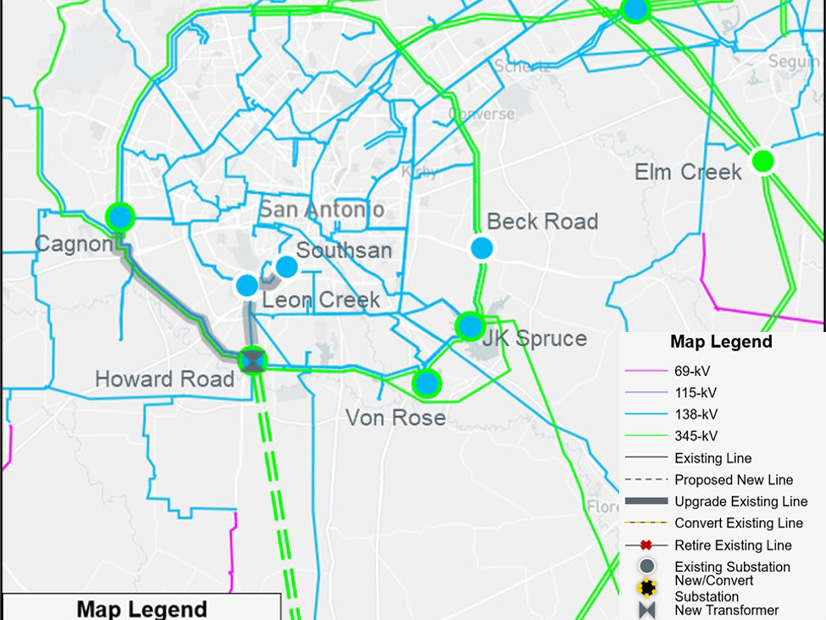ERCOT will ask its Board of Directors to approve a $329 million reliability project in the San Antonio area following an endorsement from stakeholders last week.
The Technical Advisory Committee approved the project as part of its combination ballot during its July 25 meeting, agreeing with staff’s recommendation that the project is critical to the ERCOT system’s reliability.
The project addresses thermal overloads in the San Antonio area and has been designated as a Tier 1 project because of its estimated capital costs of $100 million or more, thus requiring board approval. The board next meets Aug. 30-31.
CPS Energy, San Antonio’s municipal utility, submitted the project for the Regional Planning Group’s review in December. The staff-led RPG is the grid operator’s primary forum for discussion, input and comment on planning issues.
ERCOT staff studied five options for the project, shortlisting three. They determined the chosen option improves long-term load-serving capability and operational flexibility and provides an additional transfer path from South Texas into the San Antonio area.
The preferred option does lead to congestion on a line, but upgrading the line does not yield economic benefits, staff said, and it will not be included in the project.
The project involves building 50 miles of new double-circuit 345-kV lines and rebuilding an additional 25 miles of 345- and 138-kV lines. CPS expects to complete the project by June 2027.
RTC Stakeholder Group to Form
Now that work has resumed on real-time co-optimization (RTC), ERCOT wants to reconstitute the stakeholder group that produced seven nodal protocol revision requests (NPRRs) and two other changes to guide the ISO’s implementation of that market tool that procures energy and ancillary services every five minutes. (See ERCOT Technical Advisory Committee Briefs: Nov. 18, 2020.)
ERCOT’s Matt Mereness, who guided the RTC Task Force, will chair the proposed working group. A vice chair has not yet been identified. Work is to begin in September, with a targeted delivery of 2026.
The group will use the NPPRs to develop business requirements for RTC and single-model batteries. It also will review a state-of-charge concept for batteries. Staff are drafting a charter for the August TAC meeting.
The RTC Task Force was disbanded at the end of 2020 following completion of its work. The disastrous and deadly 2021 winter storm and the ensuring drain on staff postponed further work on RTC and batteries until recently.
Combo Ballot
TAC members approved a change to the Verifiable Cost Manual (VCMRR034) despite concerns from generators that it will create confusion over what can be included in the fuel adders. The revision provides that actual fuel purchases used to determine the reliability unit commitment guarantee will not be included when calculating fuel adders.
The measure passed 26-1, with Luminant casting an opposing vote and Calpine, ENGIE and Jupiter Power all abstaining.
The committee also considered a separate motion on NPRR1165, which would strengthen ERCOT’s market entry eligibility and continued participation requirements for qualified scheduling entities, congestion revenue right account holders and other counterparties. The measure passed 29-1, with only CPS Energy in opposition.
NPRR1165 would remove minimum capitalization requirements, require counterparties to post independent amounts, remove references to guarantors, clarify financial statement requirements and reference International Financial Reporting Standards rather than retired International Accounting Standards.
TAC’s combination ballot included three additional NPRRs, two revisions to the nodal operating guide (NOGRRs), another binding document request (OBDRR) and a change to the planning guide (PGRR). If approved by the board, these changes would:
-
- NPRR1176, NOGRR252: revise the Energy Emergency Alert (EEA) procedures to require a declaration of EEA Level 3 when physical responsive capability (PRC) cannot be maintained above 1,500 MW and require ERCOT to shed firm load to recover 1,500 MW of reserves within 30 minutes. The NPRR also would modify the trigger levels for EEA Level 1 and EEA Level 2, change the trigger for ERCOT’s consideration of alternative transmission ratings or configurations from advisory to watch when PRC drops below 3,000 MW, and restore a frequency trigger for the EEA Level 3 declaration if the steady-state frequency drops below 59.8 Hz for any period of time.
- NPRR1182: incorporate controllable load resources and energy storage resources (ESRs) into the constraint competitiveness test’s long-term and security-constrained economic dispatch (SCED) versions. Controllable load resources will not be mitigated but will be used to identify whether a market participant has market power in resolving a transmission constraint; other resources’ registration data will be used in the long-term CCT process, and real-time telemetry will be used in the SCED CCT process.
- NPRR1183: revise rules for and make publicly available on ERCOT’s website general information documents that don’t include ERCOT critical energy infrastructure information (ECEII), remove a reference to the Freedom of Information Act from the ECEII’s definition and remove antiquated or duplicative language related to reliability must run.
- NOGRR247: increase the under-frequency load shed (UFLS) program’s load-shed stages from three to five and change the transmission operator load-relief amounts to uniformly increment by 5% for each stage, add a UFLS minimum time delay of six cycles (0.1 seconds) and add 59.1 Hz to the list of UFLS stages, and revise the gray-box language from NOGRR226 to provide that the TO load value used to determine load at each frequency threshold will be the TO’s load at the time frequency reaches 59.5 Hz.
- OBDRR047: clarify treatment of unused funds from previous emergency response service standard contract terms.
- PGRR108: update language to reflect the current practice of posting regional transmission plan and geomagnetic disturbance (GMD) assessment plans and update data sets.



